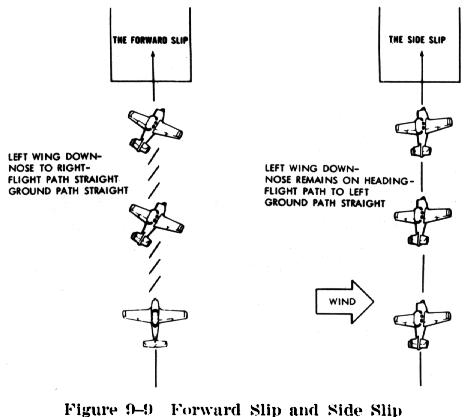
A slip is a descent with one wing lowered and the airplane's longitudinal axis at an angle to the flightpath. It may be used for either of two purposes, or both of them combined. A slip may be used to steepen the approach path without increasing the airspeed, as would be the case if a dive were used. It can also be used to make the airplane move sideways through the air to counteract the drift which results from a crosswind (Fig. 9-9).

Formerly, slips were used as a normal means of controlling landing descents to short or obstructed fields, but they are now primarily used in the performance of crosswind landings and emergency landings. With the installation of wing flaps on modern airplanes, the use of slips to steepen or control the angle of descent is no longer a common procedure. However, the pilot still needs skill in performance of forward slips to correct for possible errors in judgment of the landing approach.
The primary purpose of "forward slips" is to dissipate altitude without increasing the airplane's speed, particularly in airplanes not equipped with flaps. There are many circumstances requiring the use of forward slips, such as in a landing approach over obstacles and in making forced landings, when it is always wise to allow an extra margin of altitude for safety in the original estimate of the approach. In the latter case, if the inaccuracy of the approach is confirmed by excess altitude when nearing the boundary of the selected field, the excess can be dissipated by slipping.
The use of slips has definite limitations. Some pilots may try to lose altitude by violent slipping rather than by smoothly maneuvering and exercising good judgment and using only a slight or moderate slip. In emergency landings, this erratic practice invariably will lead to trouble since enough excess speed may result to prevent touching down anywhere near the proper point, and very often will result in overshooting the entire field.
The "forward slip" is a slip in which the airplane's direction of motion continues the same as before the slip was begun (Fig. 9-9). If there is any crosswind, the slip will be much more effective if made toward the wind. Slipping should usually be done with the engine idling. There is little logic in slipping to lose altitude if the power is being used.
Assuming that the airplane is originally in straight flight, the wing on the side toward which the slip is to be made should be lowered by use of the ailerons. Simultaneously, the airplane's nose must be yawed in the opposite direction by applying opposite rudder so that the airplane's longitudinal axis is at an angle to its original flightpath. The degree to which the nose is yawed in the opposite direction from the bank should be such that the original ground track is maintained. The nose should also be raised as necessary to prevent the airspeed from increasing.
If a slip is used during the last portion of a final approach, the longitudinal axis of the airplane must be aligned with the runway just prior to touchdown so that the airplane will touch down headed in the direction in which it is moving over the runway. This requires timely action to discontinue the slip and align the airplane's longitudinal axis with its direction of travel over the ground at the instant of touchdown. Failure to accomplish this imposes severe sideloads on the landing gear and imparts violent groundlooping tendencies.
Discontinuing the slip is accomplished by leveling the wings and simultaneously releasing the rudder pressure while readjusting the pitch attitude to the normal glide attitude. If the pressure on the rudder is released abruptly the nose will swing too quickly into line and the airplane will tend to acquire excess speed.
Because of the location of the pitot tube and static vents, airspeed indicators in some airplanes may have considerable error when the airplane is in a slip. The pilot must be aware of this possibility and recognize a properly performed slip by the attitude of the airplane, the sound of the airflow, and the feel of the flight controls.
NOTE: Forward slips with wing flaps extended should not be done in airplanes wherein the manufacturer's operating instructions prohibit such operation.
A sideslip, as distinguished from a forward slip (Fig. 9-9), is one during which the airplane's longitudinal axis remains parallel to the original flightpath, but in which the flightpath changes direction according to the steepness of the bank. The sideslip is important in counteracting wind drift during crosswind landings and is discussed in a later section.